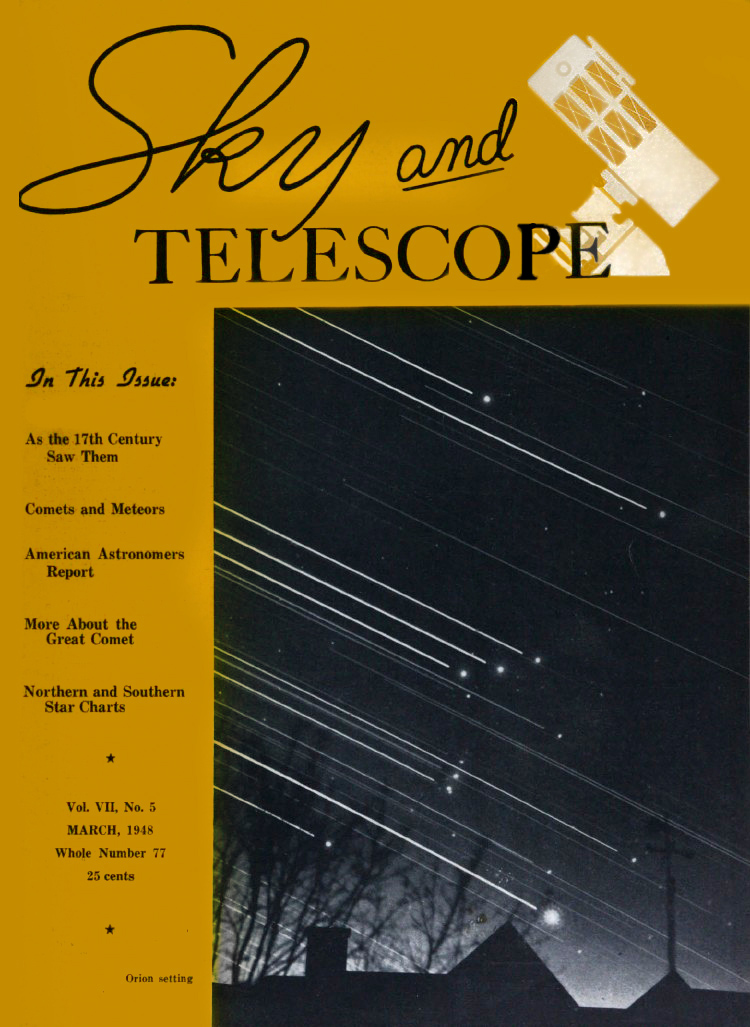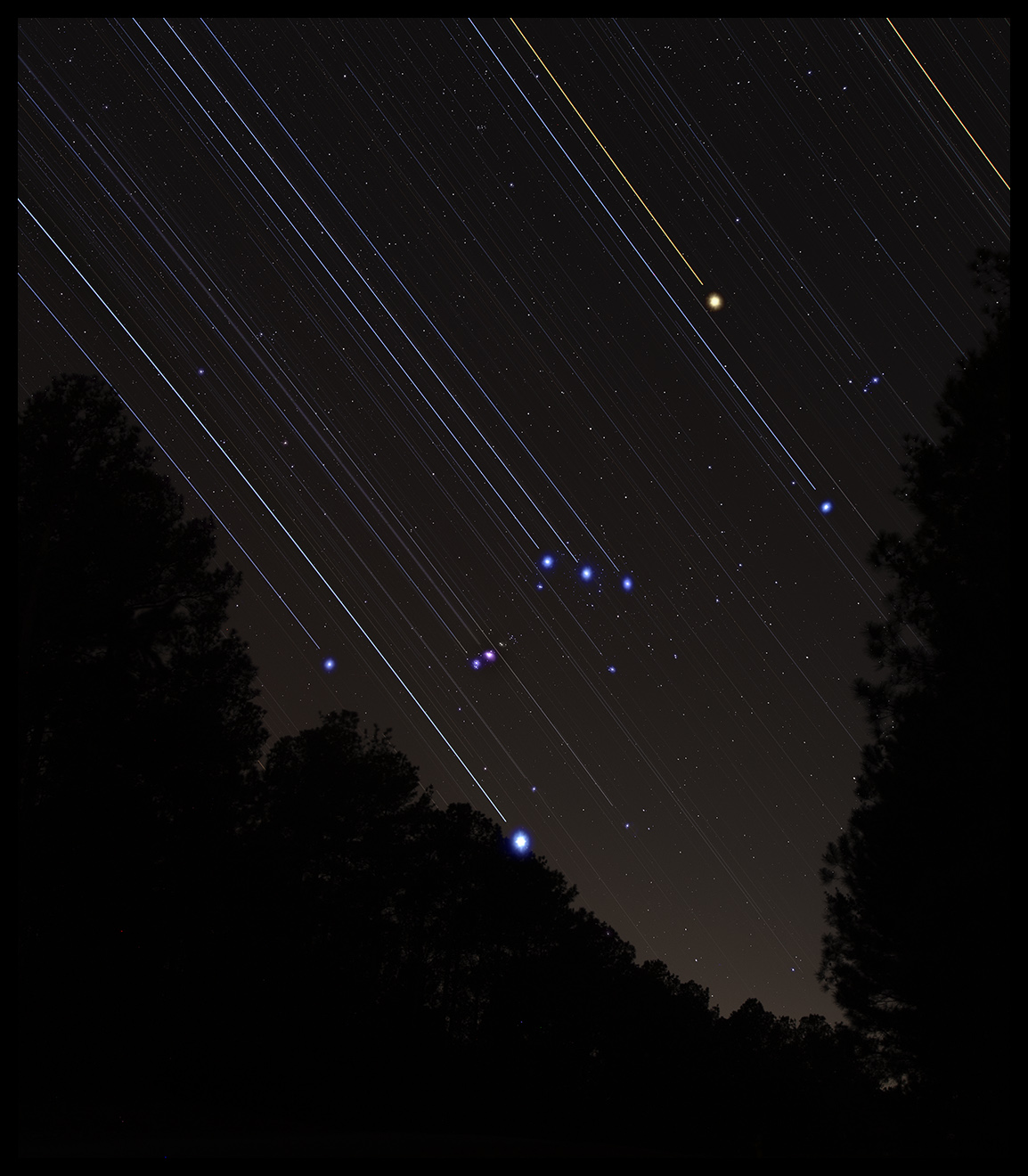Recreating a Classic Astrophoto.
2021/03/09. Remember this photo? I first saw it in Henry Paul's book, Outer Space Photography for the Amateur and then in the Golden Guide book The Sky Observer's Guide. Paul's description says it was shot on Panatomic-X; it was actually made with Kodak Panchromatic Super-XX (the difference being an ASA of 32 vs 200). The Golden Guide includes a photo of the photographer, John Stofan, demonstrating how it was done. The photo took 3rd prize in a contest organized as part of a national meeting of amateur astronomers in Philadelphia in 1947 (netting John $2) and reached the height of its success in March 1948 when it was the cover of Sky and Telescope.

I was blown away by the photo when I first saw it (1966? 1967?), but somehow I'd never tried to do it myself until last night. Here's my best effort:

This looks a lot better on a dark background.
Just click the pic. Indulge me.
John and I each let the stars trail above a stationary equatorially mounted camera, paused the exposure for a few minutes, then resumed the exposure with the camera tracking the stars. John did that first bit in one long take with his Graflex; I did it in several ten-minute subframes in my Canon 6D (to avoid light pollution and electronic noise) then layered the frames and reconstituted the long startrails in post. When John reopened his shutter, he started turning a micrometer screw so his mount would follow the stars; I flipped a switch. We each shot that last portion of the photo through a gentle diffusion filter to spread out the light of the stars, helping to mimic the way they look to the eye, and, in my case, emphasizing their colors. John tracked Orion by hand for about 30 minutes; I had a motorized platform do it for 30 seconds.
So, what do you make of the very different angles of the descending stars? Sure, John was shooting from the vicinity of Teaneck, New Jersey, and I from Rutherford College, North Carolina, but the difference in latitude between those two locations is only 5.14 degrees (40.89 - 35.75). The difference in the angles drawn by the moving stars in the photos is 26.4 degrees. If John shot Orion as it neared the horizon, as I did, as the caption says, as the horizon suggests, then he must have done so from somewhere around 62 degrees north latitude (that's the southern tip of Greenland, or the mouth of Hudson Bay, or Yellowknife, or Talkeetna). Seems unlikely to me, too.
The clue is in the full caption to the S&T publication: John added the horizon in the darkroom using a second negative. Despite the copy on the cover ("Orion Setting"), geometry suggests that Orion was doing nothing of the kind. (As for the star trails in front of the tree limbs, John explains that there was a breeze and so... could be.) Since we know the horizon was added later, Orion could have been anywhere in the sky. There's no reason to assume John's camera was level with the local horizon, but if it were -- and if he weren't way up north somewhere -- then the center of the constellation was only about one hour and 30 minutes beyond the meridian when John closed his shutter the first time. Orion was a good forty degrees up in the sky. And, assuming John's camera was level, as the horizon would have us believe, we can ask when does Betelegeuse stand barely to the left of the middle star of Orion's belt, Alnilam, as in John's photo? Answer: when it is approximately 2 hours past the meridian, about 4 hours from setting in temperate northern latitudes. The uncharitable take: I'm the guy using Photoshop, but John's doing the "cheating."
I've worked up a more comprehensive take on photographer, thespian, orator, playwright, astronomer, textile company clerk, husband, father, and all-around Lutheran mensch John Stofan -- because that's what I seem to do, Biographies Inc -- but I have no idea what to do with it.
After posting a link to this on Facebook, I realized something else. I incorporate my FB post:
The more I look at it, the more I am convinced that the original photo simply could not have been made as described: if Orion were as low as depicted the end of those trails, Rigel (the bright star at bottom right) would not have remained above the horizon for another 5 plus 30 minutes. And that horizon (though we know it was added later) could, in the story, only have been recorded during that long, stationary exposure (it would have blurred out utterly during the 30 minute tracking phase). Joihn's photo is, in fact, not really a darkroom confection of a scene that could have been captured as described but a literal fantasy. The evidence is internal; it could have been recognized (I should have recognized it) as such all along.
My deep-sky photos are made with a variety of sensors and optics. Deepest images come now from a ZWO ASI1600MM Cooled Pro CMOS camera. A good many images come from an unmodded Canon 6D. Video and video extracts begin in a Canon EOS M, usually running in crop mode via Magic Lantern firmware. Telescopes include an AT10RC (a remarkable budget Ritchey-Chretien astrograph), an Orion 10" F4 Newtonian, and a pair of apochromats: a TMB92SS and a AT65EDQ. A very early Astro-Physics 5" F6 gets some use, too. So do lots of camera lenses on both the ASI1600 and the Canon 6D. A solar Frankenscope made using a 4" F10 Orion achromat and the etalon, relay optics, and focuser from a Lunt 60 feeding a small ZWO camera will see more action as the Sun comes back to life. Mounts include an iOpton SkyTracker (original model), a Losmandy G11 (non-Gemino), and an Astro-Physics Mach1 CP3. Software is PixInsight for heavy lifting and Photoshop for polish.
:: top ::